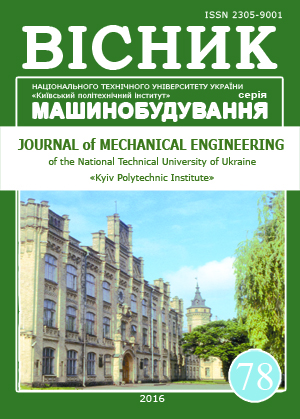EVALUATION OF METAL PLASTICITY BY COLD TWO-STAGE DEFORMATION
DOI:
https://doi.org/10.20535/2305-9001.2016.78.78690Keywords:
degree of deformation, the diagram of plasticity, deformation path tensor damage, plasticity resourceAbstract
Subject. Plasticity of deformed metal depending on the amount of used resource of ductility at the previous stage of forming and deformation story at the subsequent stage. Subject-matter: Evaluation of ductility of deformed metal and its dependence on the size and nature of the preliminary plastic deformation. Purpose of the study is to test the reliability adopted in the tensor model of damage accumulation in the evaluation of plasticity deformed metal. To evaluate the plasticity of the metal is used strain tensor model of damage accumulation process, which is based on the hypothesis of the dependence of the damage accumulation intensity on the plasticity sensitivity the of the metal to the scheme stressed state, which is described by limiting the surface deformation of the deformation story and by guiding the plastic strain increment tensor. The experiments are carried out on a joint twisting stretch of solid cylindrical sample to a certain degree of deformation and subsequent stretching before breaking. Experiments on joint twisting stretch were carried out by a special program that provides complex loading. The difference between ultimate strain calculated from the accepted model and obtained in experimental studies does not exceed 9%. Application results. Tensor model of damage accumulation, adopted in this paper, can be used to assess the estimated longevity of parts made of metal forming techniques, depending on the features of plastic deformation in their manufacture and the stress-strain state, which will take place during the details operation. Findings. On the basis of experimental studies performed residual plasticity of the material pre-deformed specimens, was proved the accuracy of the tensor model of damage accumulation in the evaluation of deformed metal plasticity.References
Bоgаtоv, А.А., Bоgаtоv, А.А., Мizhiritskiy, О.I. and Smirnоv, S.V. (1984), Rеsurs plаstichnоsti mеtаllоv pri оbrаbоtkе dаvlеniеm, Меtаllurgia, Мoscow, Russia.
Dеl, G.D. (1978), Теhnоlоgichеskаia mеhаnikа, Маshinоstrоеniе, Мoscow, Russia.
Оgоrоdnikоv, V.А. (1989), Dеfоrmiruеmоst i rаzrushеniе меtаllоv pri plаstichеskом fоrmоizmеnеnii, UМКVО, Кyiv, Ukraine.
Мihаlеvich, V.М. (1998), Теnzоrnі моdеlі nаkоpichеnnia pоshkоdzhеn, Vіnnitsia: UNІVЕRSUМ – Vіnnitsia, Ukraine.
Оgоrоdnikоv, V.А., Кisеlev, V.B. and Sivаk, I.О. (2005), Enеrgia, Dеfоrmаtsii, Rаzrushеniе (zаdаchi аvtоtеhnichеskоi ekspеrtizy),Vіnnitsia: UNІVЕRSUМ - Vіnnitsia, Ukraine.
Аliеv, I.S. (1998), “Теhnоlоgichеskiе prоtsеssy hоlоdnоgо pоpеrеchnоgо vydаvlivаnia”, Кuznеchnо-shtаmpоvоchnое prоizvоdstvо no 6, pp.1-4.
Dеl, G.D. (1983), “Plаstichnоst dеfоrmirоvаnnоgо меtаllа”, Phizikа i tеhnikа vysоkih dаvlеni, no 11. pp. 28-32.
Burennikоv, Iu.А., Sivаk, I.О. and Sivаk, Е.I. (2003), “Zаvisimоst plаstichnоsti оt shеmi nаpriazhennоgо sоstоiania pri plоskоm nаpriazhennоm sоstоianii”, Udоskоnаlеnnia prоtsеsіv і оblаdnаnnia оbrоbki tiskоm v mеtаlurgii і mаshinоbuduvаnnі. pp. 272-274.

